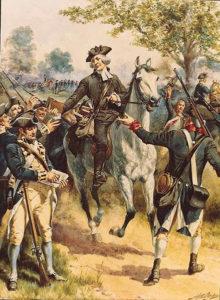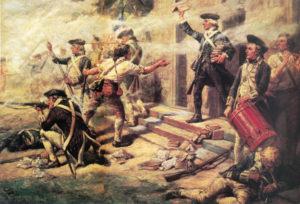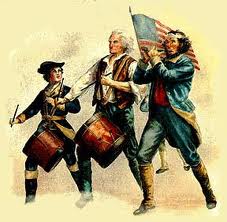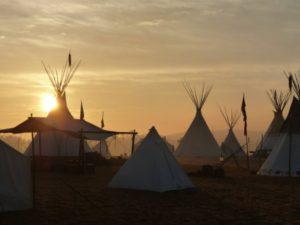
The importance of the military chaplain was critical to the success of George Washington. Here is an excerpt from his field orders issued a mere 5 days after The Unanimous Declaration of the Thirteen United States of America. Included in general orders issued July 9, 1776 was the following:
The Hon. Continental Congress having been pleased to allow a Chaplain to each Regiment, with the pay of Thirty-three Dollars and one third pr month–The Colonels or commanding officers of each regiment are directed to procure Chaplains accordingly; persons of good Characters and exemplary lives–To see that all inferior officers and soldiers pay them a suitable respect and attend carefully upon religious exercises. The blessing and protection of Heaven are at all times necessary but especially so in times of public distress and danger–The General hopes and trusts, that every officer and man, will endeavour so to live, and act, as becomes a Christian Soldier defending the dearest Rights and Liberties of his country. ~ George Washington
James Caldwell was born in April 1734, in Cub Creek in Charlotte County, Virginia. He graduated from Princeton in 1759, and was ordained the pastor of the First Presbyterian Church of Elizabethtown in 1762. Caldwell served as Third Battalion of Company No. 1, New Jersey Volunteers during the Revolutionary War, and was also Commissary to the troops in New Jersey. He was known as the “Fighting Chaplain.”
On 25 January 1780, Reverend Caldwell’s church was burned down by the enemy. He moved his family to the parsonage at Connecticut Farms (now Union), New Jersey so that they might enjoy a safer life. Unfortunately, this was not to pass.
His journey into American history arrived at the end of a hundred-year journey for religious freedom. His ancestors had fled France after the fall of La Rochelle to Richelieu’s army in 1628. They migrated to Scotland, settling on an estate known as Cold Well, named for its cold well water (hence, the origins of the family name). Episcopacy was on the rise in Scotland, so they left for Ireland, sometime prior to 1649. But civil strife involving conflicts between Scotch and Irish; economic restrictions enacted by Parliament; limitations on Presbyterian activities and a famine which began in 1725, combined to push the Caldwells out of Ireland into the New World.
His parents landed at New Castle, Delaware, on December 10, 1727, and eventually made their way to the edge of the frontier in Charlotte County, Virginia. But their longing for religious freedoms were not quite within their grasp. The Church of England dominated that part of the county, so his father, John Caldwell, and others helped send a delegation to the Governor to seek permission to settle at Cub Creek and worship as Presbyterians. The petition was granted and a church was organized in 1738. Services were held under a tree, and then a log church was built. By then James was part of the family, having been born on April 14, 1734.
Not much is known about James Caldwell’s youth, but as part of a family living on the frontier in the early 1730s he would have spent much of his time working: clearing land, feeding livestock, harvesting crops, cutting wood, hunting game and fishing. His father, as one of the leaders in the church (and in the community, serving as one of the first judges), would have conducted family devotions and taken his family to church. At some point during these years James felt the call of God upon his life and declared his desire to serve in the ministry. To help him prepare for college, he was sent to a local Classics School. In 1755, he entered the College of New Jersey (later Princeton University) and graduated three years later with seventeen others, completing classes in Greek, Hebrew, rhetoric, logic, and so forth.
Following the procedures of the Presbyterian Church, James spent the next several months studying the Bible and preparing sermons under the tutelage of Dr. Samuel Davies, then president of the College of New Jersey. He was presented for licensure examinations on March 11, 1760. After delivering the last of three required sermons on September 17, he was ordained and promptly began searching for a ministerial position. One such opening was in Elizabeth Town, New Jersey. During the eighteen months the church had been without a pastor, twenty men had applied for the office. Like those before him, he preached a trial sermon. His superior capacity for extemporaneous speaking, his animated, impressive and captivating eloquence in the pulpit, and his fervent piety, rendered him the preferred candidate and James was offered the position. He was installed with a salary of one hundred and sixty pounds in March, 1762. He was 27-years old. One year later, he added the last piece to the foundation of his life, marrying Hannah Ogden on March 14, 1763.
The next twelve years would grow as a pastor, mostly affected by the looming shadows of war. The church at Elizabeth Town was one of the oldest in the country, having been constructed in 1667. It was a congregation made up of laborers, shopkeepers, farmers, political figures and future military leaders. By God’s grace, Caldwell’s energy and forceful preaching contributed to the growth of the congregation. They soon added a sixteen-foot extension to the rear of the church. By 1776, there were 345 “pew renters.” His days were filled with the standard pastoral duties: visiting the sick, conducting weddings and funerals, attending to building matters, and helping to plant new churches. He preached two sermons every Sunday, pouring out his heart and soul: “As a preacher, he was unconsciously eloquent and pathetic; rarely preaching without weeping himself, and at times he would melt his whole audience into tears.”
To his church duties add denominational responsibilities. He maintained close connections with his alma mater, serving as a trustee. With Rev. John Witherspoon, he traveled through Virginia raising funds for the college. He was a founder of several societies, including the verbosely titled “Society for the Better Support of the Widows and the Education of Children of Deceased Presbyterian Ministers in Communion with the Present Established Church of Scotland.” He served on a committee to promote missionary work among Indians; he was on a committee to select, procure and distribute religious books and hymnals; and, sat on a committee to encourage missionary work in Africa and examine the church’s position on Negro slavery. And he served as a faithful husband and father to ten children.
From the start of the American Revolution, Caldwell was an ardent supporter and was not ashamed to proclaim so from the pulpit. When the recriminations, protestations and tensions finally broke out into flying musket balls and cannon fire on the fields of Lexington and Concord in April, 1775, James Caldwell was ready. At a meeting of the Presbyterian Synod in May he again served with Rev. Witherspoon and was appointed to a committee to formally urge the Presbyterian churches to support the rebellion. These actions made the Presbyterians, and especially their clergy, targets for revenge. Back home he preached thunderous sermons, pleading for loyalty to the cause. Thirty-one officers and fifty-two enlisted men were to come out of the Elizabeth Town Presbyterian church. Though it was common for ministers to preach the cause of liberty, few stepped out of the pulpit into the line of duty. James Caldwell was one of the few.
He had already been working for the budding Revolution as a member of the Committees of Correspondence, which had helped disseminate news about anti-British activities prior to the war, and then once hostilities broke out helped recruit soldiers, materials and arms. As chaplain, he went wherever his troops went. This meant that he was in a position to minister, not only to the soldiers, but also to the residents of nearby towns. He preached, held baptisms and too often, funerals. As he had in his home town, he quickly gained a reputation for his preaching, as was written of him: His countenance has a pensive, placid cast; but when excited, was expressive of high resolution and energy. It was said that his voice became sweet and musical, and yet so strong that, when needful, he would make himself heard above the notes of the drum and fife.
The American War for Independence was on the edge of disaster entering 1780. More than 600 had deserted Washington’s army in Morristown, N.J., helped along by a more severe winter than that suffered at Valley Forge. Pockets of mutiny had sprung up throughout the winter and into the spring. Then, in May 1780, Charleston, S.C., fell to British General Charles Cornwallis. For Reverend James Caldwell, the year of 1780 would prove to be a year of suffering and sorrow for the soon to be “Fighting Chaplain.” First, a night raid by the British against the town left the courthouse and Presbyterian Church burnt to the ground. Caldwell lost many personal papers, as well as church records and documents.
On 6 June 1780, Lieutenant General Baron Wilhelm von Knyphausen crossed over from Staten Island into New Jersey with six to seven thousand German soldiers. He was on his way to Springfield, but first there was a skirmish at Connecticut Farms where Caldwell had earlier relocated his family. When word reached the town of the invasion, Caldwell made arrangements to once again move his family. His wife, however, did not wish to leave. It is speculated that she did not want to travel with the young children, or that she felt safer in her house than out on the open road. Whatever the reason, she stayed behind while the older children were sent to friends in another town. James then rode off to join his brigade. It was a fateful decision. While the noises of war—whizzing musket balls, braying horses, shouting troops—filled the air, Hannah made a few nervous preparations. She hid several items in a bucket, lowering them into the well; she pocketed some silverware. She put on nicer clothes, in case she would have to address a British officer, and then retreated to her bedroom with her youngest children. “Mrs. Caldwell felt confident that no one would have the heart to do injury to the inhabitants of the house. Again and again she had said, ‘They will respect a mother.’” She was wrong. As the British marched into town, a redcoat jumped the fence, came up to the house and shot through the window, splattering glass, killing Hannah Caldwell with a ball through the chest. Other soldiers poured into the house. They pilfered her pockets, looted the house and took five hundreds sermons James had written out in longhand. Thankfully, her body was removed before they torched the home. For several hours she was left exposed in the open air, clothes torn and disheveled, until neighbors took her in. The day ended with the British setting fire to the village.
James was with General Lafayette on the heights near Springfield. When he saw the smoke he said, “Thank God! The fire is not in the direction of my house.” He was wrong and soon overheard the truth from returning soldiers. He rushed back to the town to find his wife, and the mother of his ten children, gone. The funeral was held that afternoon. Following the death of his wife, Caldwell made provisions for his children then continued his duties. He kept on preaching and attending to the troops. The news of the murder lit up the country with indignation, but for James, there was no time to mourn. Indeed, in a mere two weeks he would be riding the countryside, sounding the alarm of the British advancement on Springfield.
As Knyphausen marched down the main turnpike, he met American Colonel Israel Angell, bunkered down in an apple grove across the Rahway River. The Redcoats moved up and let loose a furious volley, using 6 artillery pieces. The broadside tore off chunks of the apple trees and killed the American regiment’s lone artillery gunner. Despite the crucial loss, Colonel Angell held off a force five times larger than his own for 25 minutes. During the heat of the battle, the American militia began to run out of wadding, the paper used to roll powder and ball, thus sealing the barrel so they could continue shooting at the enemy. Reverend James Caldwell sprang into action. Caldwell was said to have dashed into a nearby Presbyterian Church, scooped up as many Watts hymnals as he could carry, and distributed them to the troops, shouting “put Watts into them, boys.” The boys responded and poured lead into the oncoming enemy.
 Caldwell’s legendary deed did not turn the course of battle that day. At best, it delayed the invasion of Springfield by a few minutes. But the event stirred such patriotic fervor that those who witnessed it passed it on to succeeding generations until Washington Irving recorded it in his biography of George Washington. For the “Fighting Chaplain,” it was just one more selfless act in a life full of courage, patriotism and disinterested service to others and God.
Caldwell’s legendary deed did not turn the course of battle that day. At best, it delayed the invasion of Springfield by a few minutes. But the event stirred such patriotic fervor that those who witnessed it passed it on to succeeding generations until Washington Irving recorded it in his biography of George Washington. For the “Fighting Chaplain,” it was just one more selfless act in a life full of courage, patriotism and disinterested service to others and God.
On Nov. 24, 1781, Reverend Caldwell went to greet Beulah Murray, who was scheduled under a flag of truce to visit some relatives. She had rendered service to American prisoners in the prison ships in New York and was held in esteem. He drove a chaise, thought to be a light open two-wheeled carriage, to Elizabeth Town Point along Newark Bay to bring her to town. He could not find her. He went on board the sloop. Upon debarking with a bag, a sentry ordered him to stop. American authorities were battling smugglers of British goods from New York to New Jersey. Strict orders had been issued to all sentries to look for illicit trading. After walking Ms. Murray to his carriage, he returned to the boat, to retrieve a package that was left behind. On the return back to his carriage, an American sentinel, named James Morgan, challenged him, asking what was in the package. Caldwell attempted to proceed to the proper officer with the package, but as he attempted to move away, the sentinel, just relieved from duty, fired his musket, killing the Reverend Caldwell with two balls. Caldwell had stopped, but the sentry shot him anyway. James Caldwell, the “Fighting Chaplain,” dropped dead. The sentry, James Morgan, was hanged for murder on January 29, 1782 in Westfield, New Jersey, amid rumors that he had been bribed to kill the chaplain.
There were ten orphaned children of Hannah and James Caldwell, all of whom were raised by friends of the family. Caldwell lived a full life. One marvels at the breadth of his service to his country and his Savior. It is easy to imagine that he might have gone on to serve his country in the new Republic as one of the Founding Fathers. What distinguishes James Caldwell from most other clergymen of his day is that, while he continued his ministerial activities during the struggle for freedom, he also performed other services demonstrating his devotion to that cause. Others, from many different walks of life, exhibited the same devotion and made sacrifices. But James Caldwell, as the minister who stood with the fighting men in the midst of battle, who rallied others to continue the war when the situation appeared hopeless, who unwittingly sacrificed the life of his wife when he considered it his duty to be with the troops, and who met his own death while performing a helpful service for someone else, stands out above many others.
The Reverend James Caldwell and his wife were buried in the churchyard of the First Presbyterian Church in Elizabethtown. A monument to him in Elizabeth, New Jersey was dedicated in 1846.
More information on the Battle of Springfield: http://en.wikipedia.org/wiki/Battle_of_Springfield_(1780)
The information contained in this document was taken from the following sources:
http://www.leben.us/index.php/component/content/article/62-volume-4-issue-2/254-james
http://americanrevolution.org/women/women44.html
http://www.thisday.pcahistory.org/2012/06/june-23-rev-james-caldwell/
http://dansamericanrevolutionblog.blogspot.com/2009/07/reverend-james-caldwell-and-battles-of.html
 John Jay was born on December 12, 1745, to a wealthy family of merchants and government officials in New York City. His father, Peter Jay, was born in New York City in 1704, and became a wealthy trader of furs, wheat, timber, and other commodities. On the paternal side, the Jays were a prominent merchant family in New York City, descended from French Huguenots who had come to New York to escape religious persecution in France. In 1685 the Edict of Nantes had been revoked, thereby abolishing the rights of Protestants and confiscating their property. Among those affected was Jay’s paternal grandfather, Augustus Jay. He moved from France to New York, where he built up a successful merchant empire.
John Jay was born on December 12, 1745, to a wealthy family of merchants and government officials in New York City. His father, Peter Jay, was born in New York City in 1704, and became a wealthy trader of furs, wheat, timber, and other commodities. On the paternal side, the Jays were a prominent merchant family in New York City, descended from French Huguenots who had come to New York to escape religious persecution in France. In 1685 the Edict of Nantes had been revoked, thereby abolishing the rights of Protestants and confiscating their property. Among those affected was Jay’s paternal grandfather, Augustus Jay. He moved from France to New York, where he built up a successful merchant empire.


